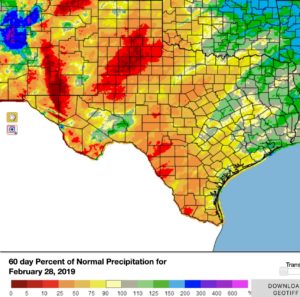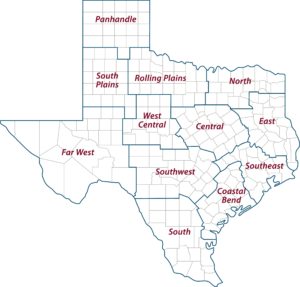Too Dry or Too Wet, Soil Moisture Levels Delay Texas Plantings
Despite soggy conditions delaying crop plantings in large swaths of the state, many areas are still contending with dry to drought conditions, according to the Texas state climatologist.

This graphic shows parts of the state that have received above- and well below-average precipitation since late December, according to National Weather Service data. (Graphic by the North Carolina State Climate Office)
Dr. John Nielsen-Gammon said a weak El Niño pattern, which typically brings rain to much of the Southern states, delivered above-normal amounts of rain to parts of the state while missing some areas altogether.
Nielsen-Gammon said West Texas, the Panhandle and parts of South Texas did not receive typical fall and winter storms. Fall and winter aretypically when soil moisture indexes recharge following hot, drier summer months.
California and the southeastern U.S. picked up more consistent rain than Texas from the El Niño weather pattern, he said.
“The rain events were more spotty than usual this fall and winter,” he said. “But the expectation is for a continued tendency toward wet weather through spring. Those areas could pick up some moisture over the next month, beginning this week.”
Producers in wet areas can only hope those storm fronts won’t deliver more rain, he said.
“There was a lot of rain in the fall, especially in East and Southeast Texas,” Nielsen-Gammon said. “It takes a long time for soils to dry during the cool season.”
Forecasting winter weather temperatures and moisture potential is typically accurate. But Nielsen-Gammon said it’s difficult to predict how summer weather will progress due to randomness of thunderstorms and tropical disturbances.
Much of the state also experienced below-normal temperatures, Nielsen-Gammon said.
A recent freeze event around the state may seem atypical because warm spells and good moisture promoted green growth and an early bloom in many parts of the state. But, he said, the last spring freeze in College Station is typically March 15.
“It’s not unusual to have cold weather at the beginning of March,” he said. “There’s a lot of talk about extreme temperature variability, but there are no trends indicating that to me.”
AgriLife Extension district reporters compiled the following summaries:

The 12 Texas A&M AgriLife Extension Districts
CENTRAL: Extremely low temperatures damaged fruit trees that had bloomed. Corn plantings were underway. Needed rain was in the forecast. Supplemental feeding of cattle was still necessary. Producers were top dressing small grain pastures. Pastures looked almost ready grow and green up. Good weather allowed some field work. Most producers were trying to plant corn. Pastures and rangelands were looking good. Nearly all counties reported good soil moisture and crop conditions.
ROLLING PLAINS: Weather was dry with temperatures ranging from 15-70 degrees. Producers were making fertilization plans for forage management. Pastures, rangelands and winter wheat and oat fields were in poor to fair condition.
COASTAL BEND: Soil moisture levels were high. A freeze occurred in the northern end of the district. Although minimal corn acres were planted, farmers were expected to assess damages to seedling corn. In the southern end of the reporting area, some corn was planted and some previously planted fields had emerged. However, plants were slow growing due to cooler temperatures. Some sorghum was planted and emerged. A small amount of cotton was planted as temperatures warmed. If dry conditions continue, more cotton should be planted soon. In other areas, field conditions were still too wet for planting, and no field activity had taken place. Rangeland and pasture conditions continued to improve as cool season annuals and perennial grasses were growing. Livestock were still provided hay, if available, but slowed down consumption as pastures greened up. Cattle were in good condition.
EAST: Conditions continued to be cold and wet across the district. Several nights were below freezing, which caused severe damage to fruit tree blooms in Cherokee County. Pasture and rangeland conditions were fair to poor. Subsoil and topsoil were adequate to surplus. Hay was in short supply, and many producers were running out of hay. Some producers in Anderson County were finishing up winter feeding with grain. Sabine County producers were hesitant to start field work for forage and hay due to forecasted rain. Polk County reported frost damage to pastures with cool-season forages and warm-season grasses. Livestock were doing fair to good with supplemental feeding taking place. Cattle market volume and prices were both down in Houston County. But the cattle market was firm in Anderson County despite low numbers due to wet pasture conditions. Timber harvests slowed due to wet conditions. Wild pigs continued to cause damage.
SOUTH PLAINS: Subsoil and topsoil moisture levels remained very dry due to lack of rain and high winds. Pastures, rangelands and winter wheat fields needed moisture. Producers continued to prepare for spring planting. Fire danger warnings started to be issued due to extremely dry conditions in some areas. A chance for rain was in the forecast. Cattle were in good condition.
PANHANDLE: The district received minimal precipitation. Pastures still needed moisture. Cattle received supplemental feed to maintain good condition. Weather conditions fluctuated between cold, windy and warm. Winter wheat hung on despite the lack of moisture, and conditions ranged from fair to poor across most counties. The majority of subsoil in the district was short on moisture.
NORTH: Soil moisture levels were surplus for a majority of counties reporting. The hay situation was a huge concern for producers as supplies ran low. Fruit farmers were concerned about potential damage to trees and yields after temperatures dropped into the upper teens. Farmers were waiting for a break in the rainy weather to plant corn or sorghum. Wheat pastures looked bad all winter and producers were hoping dry, warmer weather would arrive to jump start growth. Livestock showed signs of stress from varying temperatures. Wild pigs were very active.
FAR WEST: Temperatures varied from highs in the upper 80s to lows in the high teens. No significant precipitation was reported. High winds created drying issues for crops. Fire damage was a concern due to high winds and lack of rainfall. Farmers checked crops for damage due to extremely low temperatures. Early planted wheat and triticale could be damaged, but no assessments were reported. Weather conditions were not yet optimal for corn and sorghum planting. Project water was not scheduled to be received until June, which caused many acres to not be planted. Some early irrigation of pecan trees began. Areas of the district received extremely high temperatures for this time of year. Temperatures caused wheat conditions to decline. Farmers were beginning to prepare fields for cotton. Pasture grasses were in poor condition due to lack of moisture, but weeds continued to bloom. Producers continued to lamb and kid sheep and goats.
WEST CENTRAL: Weather was cold with several hard freezes before becoming unseasonably warm. Many fruit trees had already set blooms with unseasonably warm weather in February. Losses were expected. All areas needed rain. Livestock were in fair to good condition. The cattle market held steady after several weeks of increases. Choice stocker steers and heifers sold steady. Some real fleshy calves sold $5 lower per hundredweight than their counterparts. Feeder steers were steady and feeder heifers were steady to $2 lower per hundredweight. Packer cows and bulls, pairs and bred cows were steady.
SOUTHEAST: Some areas were still excessively wet. Sunshine and slightly warmer temperatures should initiate plant growth. In Brazos County, warmer temperatures and wind helped dry out wet fields. More rain was expected. Wet conditions prevented field preparations, so rice was expected to be planted late. Cattle producers were told to be aware of nitrate poisoning in last year’s hay. Rangeland and pasture ratings varied from fair to very poor with fair being most common. Soil moisture levels ranged from adequate to surplus with surplus being most common.
SOUTHWEST: Temperatures were below freezing before turning warmer. No rain was reported. Farmers worried about crops that were planted already, but some were planting. Livestock received supplemental feed.
SOUTH: No rainfall was reported. All areas of the district reported cool weather conditions, including below-freezing temperatures. Northern, eastern and southern areas reported short to adequate soil moisture levels. Western parts reported cooler weather and very short soil moisture levels. No freeze damage was reported on recently planted sweet corn, potatoes and wheat. Corn and sorghum planting were reported around the district. Wheat and potato crops were under irrigation. Pasture and rangeland conditions were fair to poor. Livestock feed supplementation continued. Cattle conditions were improving due to abundant winter weeds and oat fields. Near-freezing temperatures kept cotton farmers from planting. Harvest of the spinach and cabbage was active. Warmer temperatures should increase forage production on native rangelands and pastures. Ginning activities were expected to continue through the middle of April.
Source: Texas AgriLife Extension
